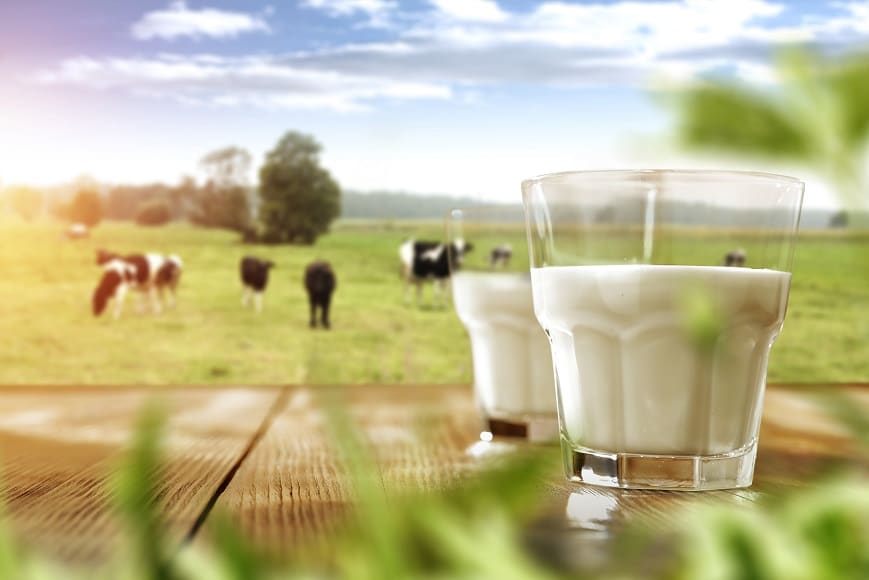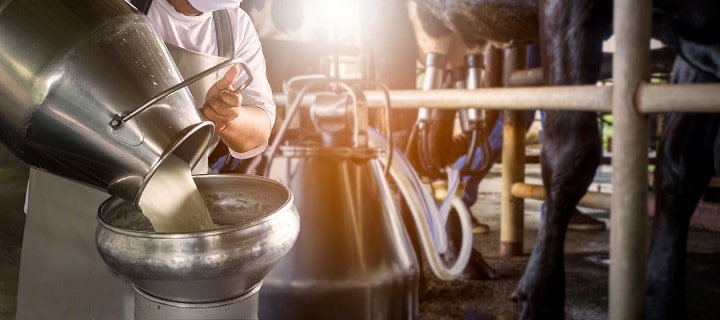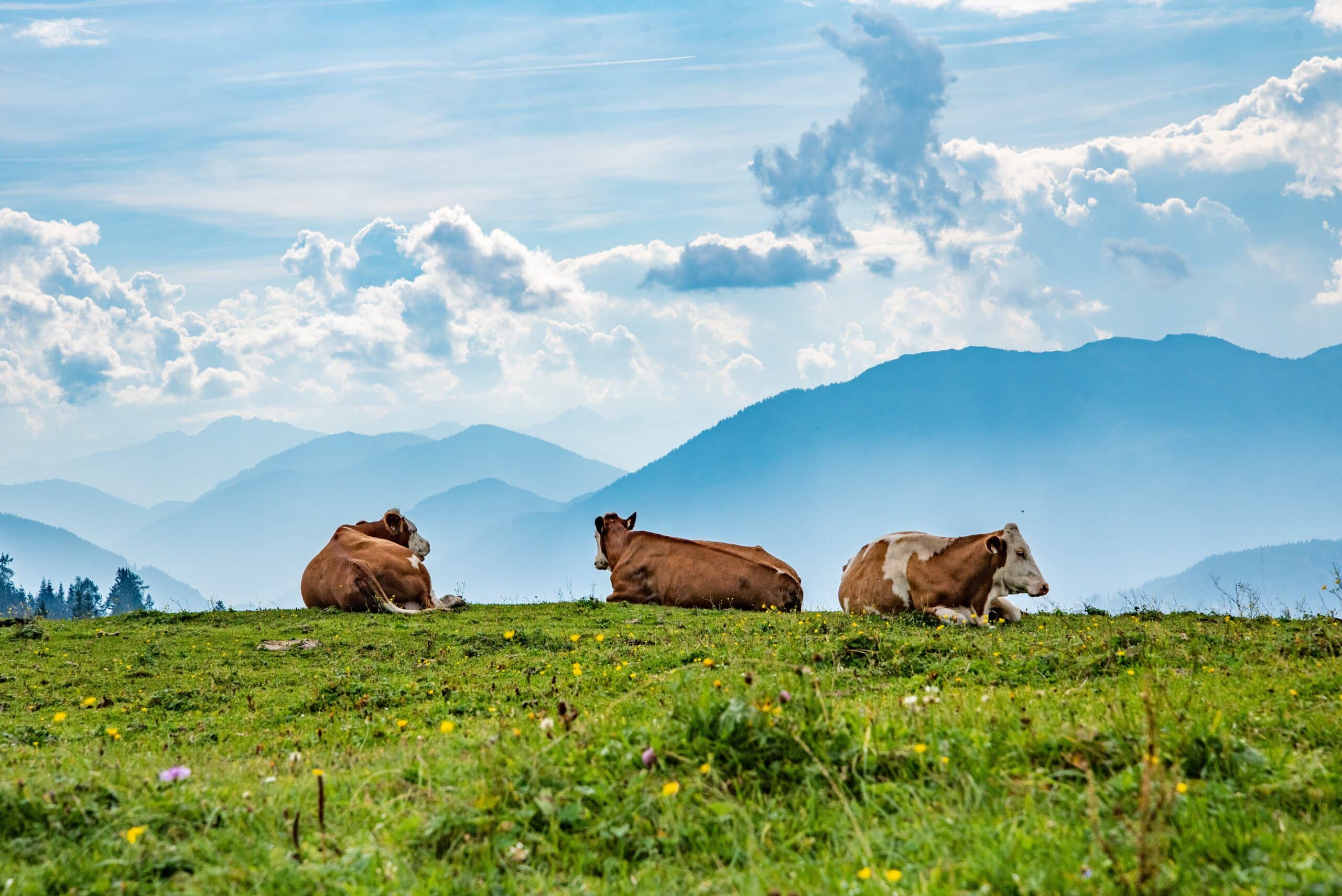
What is a dairy farm business?
A dairy farm is a company that specializes in the long-term production of milk, which can then be processed on-site or at a dairy plant.
Like any other business, a dairy farm is successful when managers and/or owners focus on sustainable growth, specifically on elements like:
- Understanding the biological processes that drive raw milk production and the technology that can support them. The right equipment and tools can facilitate operations inside a dairy farm business for better health and safety policies and increased efficiency.
- Operating day-to-day activities profitably with respect for the environment and the final product. Successful dairy farm managers know how to optimize livestock feeding and herd size to control costs and ensure consistent milk production.
- Making educated, long-term investments to protect their assets and increase profitability over time. Keeping track of farm costs and returns and identifying new ways to control costs without sacrificing quality can make the dairy farm more profitable in the long run.
Global milk market demand
The pandemic has influenced the global dairy market generating a significant increase in the demand for dairy produce. After the initial growth, the global dairy market is expected to slow down in 2022, as milk prices struggle to keep up with production costs.
However, predictions for the next five years look promising for dairy farmers. The market is expected to register a compound annual growth rate of 5.2% between 2022 and 2027 as consumers become more aware of the importance of healthy nutrition and how dairy products can contribute to a balanced lifestyle.
Asia-Pacific continues to be the largest market for milk and milk-based products, but growth is expected to occur at similar rates in North American and European markets.
Can dairy farms really make a profit?
It depends on a series of factors, of which one of the most important seems to be the herd’s size. For example, the University of Minnesota revealed the following stats for 2019:
- Dairy farms with a herd size between 40 and 60 cows registered significant losses.
- Dairy farms with 150 cows and more see small profits.
- Dairy businesses with herds between 300 and 600 cows or larger bring more significant profits.
It’s the result of how milk production costs vary with the business’s size. Large farms can negotiate better prices for food, medicine, and other materials than small farms, which means they can halve their costs. They’re more profitable because they manage to keep expenses down in ways that aren’t accessible to a farm with a herd of 50 cows.
Keeping costs down is an ongoing challenge in this industry, but they’re the key to successfully countering the changes in demand, unpredictable weather, and milk price fluctuations. Between labor costs, equipment, and estate management, keeping your eyes on cash flows is the game-changer when looking to build a profitable dairy farm.

Pros and cons of owning a dairy farming business
Advantages:
- It’s a rewarding business that feeds people and supports a healthy lifestyle.
- You get to consolidate relationships with other companies in the same industry and build a solid network that can support long-term growth.
- The demand for dairy products is expected to grow consistently in the future.
- The barrier to entry is relatively low compared to other industries, and you can easily learn your way up to making a profit.
- Once you learn how things work, the business model is straightforward to keep up with.
Disadvantages:
- Managing a dairy farm is hard work and includes much physical activity every day, even when you don’t feel like taking care of the herd.
- Employee retention rates are low, and you might find yourself often forced to hire and train new staff, which can quickly increase costs.
- Dairy farming isn’t always eco-friendly; your business can become a threat to the environment instead of a purposeful activity depending on your management decisions.
- Making the business profitable can take a while, so you might need extra cash to keep the farm running at first.
- The weather can significantly impact cattle productivity in the dairy industry.
How to start and maintain a dairy farm business
- Finding the right location
For your dairy farm business to be profitable, you need to produce at least part if not all forages. So, you need enough land to grow grains and other food for your herd. Ideally, you want to pick a location where future expansion is possible so you can support long-term growth.
At the same time, you need a place to sell your milk quickly and with minimum additional costs to your farm. The shorter the distance between you and your potential customers, the easier it becomes to sell the milk for affordable prices and still have good margins.
Last but not least, you need a clean water supply that can provide the necessary amounts of water to support all your farm’s needs.
- Building the farm
Dairy cattle require clean and dry resting spaces. Freestalls or bedded packs provide comfortable housing solutions for cows that need to lie or rest without limiting mobility. As a rule of thumb, you can calculate how much space needs to be allocated to each cow with a simple rule: you want to provide enough room so your biggest animal can freely enter the stall, lie down, rest comfortably, and get back to its feet.
On average, this rule translates into about 50 square feet of room for each animal in the freestall. If you build a close-up facility, you should provide approximately 100 square feet of space for each cow.
Ideally, you can build a separate space for calving for health and safety reasons.

- Selecting the best breeds
Finding the right dairy cows to grow can be challenging and depend on your location and freestall capacity. You must run market and competitor research to understand what breeds are already growing in the area and how profitable they are by farm size.
The best dairy cow breeds are Holstein, Red and White, Jersey, Brown Swiss, Milking Shorthorn, and Guernsey. You can narrow your options and make the best decision when selecting the breeds for your dairy farm by talking to a veterinarian and other experts in your area.
- Optimizing a feeding program
Dairy cattle require specific nutrients to produce high-quality milk and reproduce, so you need to work with an expert to establish the proper diet for each category of cows you keep on the farm.
When you know how much food you need for your herd, you get to make better decisions around how much food to cultivate or buy, and depending on production costs, it can also influence the size of your herd in any given year.
- Planning waste management
Waste management is one of the most challenging parts of managing a dairy farm business, as dairy cattle produce impressive amounts of manure each day. The numbers speak for themselves:
- A 1,400-pound dairy cow can generate around 120 pounds (1.9 cubic feet) of feces and urine each day.
- Every cow housed in freestall total confinement produces over 2.5 cubic feet of waste between feces and milking wash wastes.
- If you manage 100 cows, this is nearly 9 tons and 9+ cubic yards of manure per day.
- If you manage 100 cows on pasture part-time, you accumulate about 4.5 tons and 5 cubic yards of manure per day in confinement.
Without an effective waste management system, you risk producing too much waste and creating major disruption to the local environment, with significant consequences on the life and health of your entire community.
The good news is that cow waste can be put to good use. With the right waste management system in place, you can quickly turn cow dung into biogas, positively impacting your business and the environment. This way, you can produce energy from renewable sources on-site and fertilizer so nothing goes to waste, and you get to produce more with fewer resources for increased efficiency.

HomeBiogas 6
Designed for the next generation of green innovation.
- Creating a realistic budget
Paying for land, construction, equipment, crops, and dairy cattle can quickly become a considerable expense, and profits don’t always come easily in this business. You need to budget wisely and be ready for unpredictable outcomes, such as reduced productivity due to climate change, milk price decline, or medical expenses.
How to write and execute a dairy farm business plan
Writing the business plan
Your business plan should include the following chapters:
- An Executive Summary in which you explain what you want to do and make educated predictions on possible outcomes considering the current state of the dairy industry in your region.
- An intro that defines your business model and highlights the principles that will govern the farm and any previous experience in the industry to help you achieve your business goals.
- A section that explains what makes your location suitable for starting and managing a dairy farm.
- A chapter dedicated to initial costs in which you list and explain every expense necessary to plan and start the dairy farm business, from buying or renting the land to paying for the cows and initial food stock.
- A market analysis summary that highlights the demand for dairy products in the area, all potential business partners and customers, competitors that might keep you from selling your products, and any organizations that can support you as you build your business.
- A comprehensive list of products and services that can bring income outsode selling milk.
- A chapter dedicated to waste management, as this part of a farm’s activity can become a barrier to growth and profitability in the long run.
- A chapter dedicated to finances and pricing that help you estimate ongoing production costs, insurance premiums, revenue, and profitability.
- A section dedicated to compliance with local and national rules and regulations regarding dairy farm management.
- Your marketing and sales strategy in which you describe how you plan to position yourself on the market and what techniques can help you get customers and maintain a good relationship with them.
- A section on management to explain how you plan to employ the right staff, manage daily activities, take care of the dairy cattle, and oversee all the other activities necessary to manage a dairy farm business.
Executing the business plan
Writing the business plan is just the tip of the iceberg. After you have cleared what your business will look like, you need to put together a tactical plan to turn your business idea into practice.
Start with making a list of activities you and your employees need to perform to keep the business running. This list must include everything that needs to happen every day, what equipment you will use, and how many people are necessary to perform each task.
Start with the daily activities:
- Feeding the cattle
- Providing fresh water
- Cleaning the spaces
- Medical care
- Milking the cows
- Storing the milk
- Waste management
- Marketing and sales
Continue with other regular activities:
- Invoicing and bookkeeping
- Tax work
- Staff training
- Additional planning, goals evaluation, and other management activities.
Set clear goals and milestones to measure your progress and evaluate your performance. This way, you can identify what works and what needs to be changed to increase profitability and improve conditions on the farm.
How HomeBiogas is helping dairy farmers
HomeBiogas systems provide an effective method for managing cow waste using anaerobic digestion. This natural process enables dairy farmers to use cow dung to produce biogas that can be used as cooking gas, with multiple extra benefits:
- You lower your farm’s carbon footprint.
- You remove waste from landfills, reducing the amount of methane released into the atmosphere.
- You produce 100% organic fertilizer you can further use to balance the soil and obtain better crops to feed your cattle.
The system includes a digester where bacteria break down the organic waste, produce fertilizer, and supply gas from organic matter. It’s a zero-waste process that reduces your business’s impact on the environment while permitting you to have cleaner energy than by using fossil-fuel sources.

Conclusion
Starting and managing a dairy farm business requires a good plan and a willingness to embrace the challenges of growing dairy cattle. It’s hard work, rewarding and demanding, especially as some of the elements that can influence your bottom line are out of your control.
It’s hard to make accurate long-term predictions between global dairy market fluctuations and climate change. However, taking risks can also pay off, and the more you learn how to manage the farm without increasing your production costs, the higher your chances of building a profitable business in this industry.






